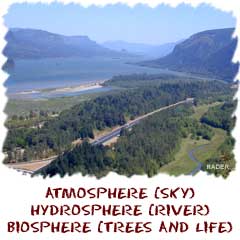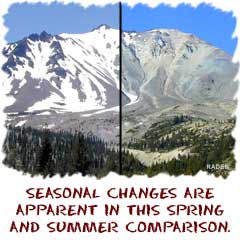 The biosphere is all about life. Physical geographers use the term biosphere to describe our living world. All of the microbes, plants, and animals can be found somewhere in the biosphere. The biosphere extends to the upper areas of the atmosphere where birds and insects can be found. It also reaches to dark caves deep in the ground or to the bottom of the ocean at hydrothermal vents. The biosphere extends to any place that life of any kind might exist.
The biosphere is all about life. Physical geographers use the term biosphere to describe our living world. All of the microbes, plants, and animals can be found somewhere in the biosphere. The biosphere extends to the upper areas of the atmosphere where birds and insects can be found. It also reaches to dark caves deep in the ground or to the bottom of the ocean at hydrothermal vents. The biosphere extends to any place that life of any kind might exist. The biosphere is the crossroads of all the other earth science spheres you will study in class. Think about the possible interactions for a second.
- The land of the lithosphere interacts with the oceans of the hydrosphereat the coastlines. The coasts are teeming with life such as fish, birds, invertebrates, and mammals.
- The land also interacts with the air of the atmosphere and differentclimates. Rising mountains cool the air and force clouds to drop their water, leading to rain for forests of trees and rivers filled with fish.
- There is even interaction between the forces deep in the Earth and energycoming to the Earth from space. Volcanic vents under the seas are surrounded by life.
All of these interactions create the variety in our living world.
Big, Small, and the Smallest Factors
 Many factors affect the biosphere and our life here on Earth. There are large factors such as the distance between the Earth and the Sun. If our planet were closer to the Sun, it might be too hot to support life. If we were further away, it might be too cold. The tilt of the Earth is just as important. Seasons and seasonal climate changes are direct results of the tilt of the Earth towards or away from the Sun. Summer months allow half of the planet to warm while the other half cools. Six months later, the temperatures shift in the opposite direction.
Many factors affect the biosphere and our life here on Earth. There are large factors such as the distance between the Earth and the Sun. If our planet were closer to the Sun, it might be too hot to support life. If we were further away, it might be too cold. The tilt of the Earth is just as important. Seasons and seasonal climate changes are direct results of the tilt of the Earth towards or away from the Sun. Summer months allow half of the planet to warm while the other half cools. Six months later, the temperatures shift in the opposite direction. Smaller factors also act on the biosphere. If you were to watch a piece of land that was only one square mile (or kilometer), you would see the influence of climate, daily weather, and erosion. These smaller factors change the living space and organisms must react accordingly. For example, how would a family of gophers react if their burrow gets washed away in a mudslide? Even though humans are able to control much of their immediate environment, they are still vulnerable to weather and earthquakes.
The smallest of factors in the biosphere work on a molecular level.Chemical erosion is a great example of a landscape changing one molecule at a time. Oxidation and reduction reactions change the composition of rocks and organic materials. There is also biological erosion. Tiny organisms, such as bacteria and fungi, are constantly working to break down organic and inorganic materials.








0 comments:
Post a Comment